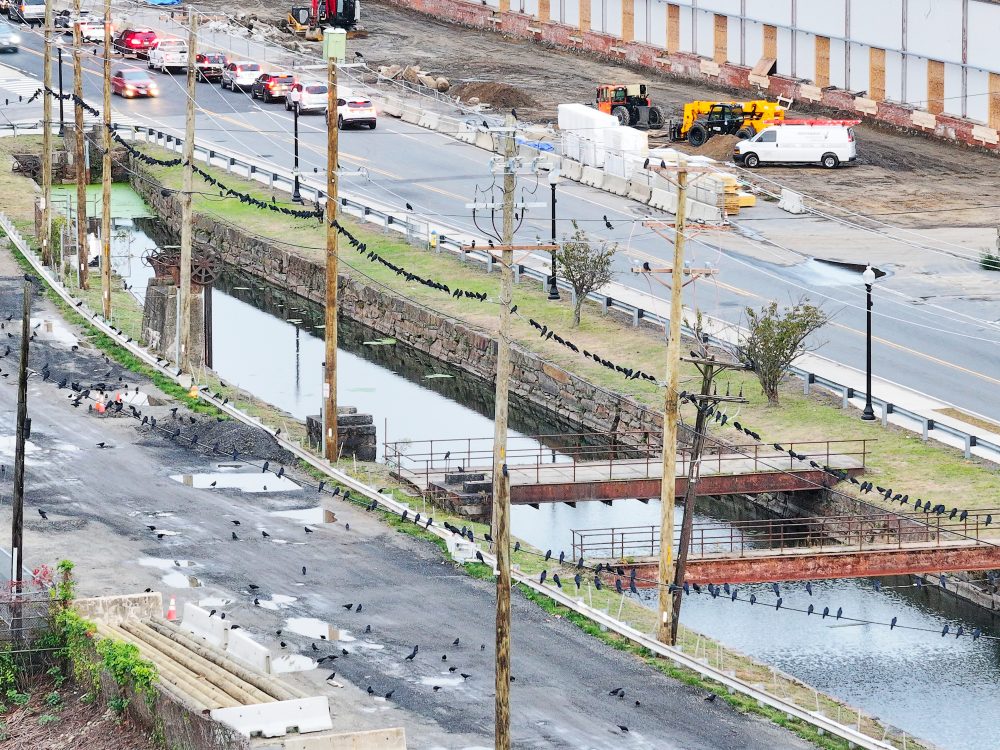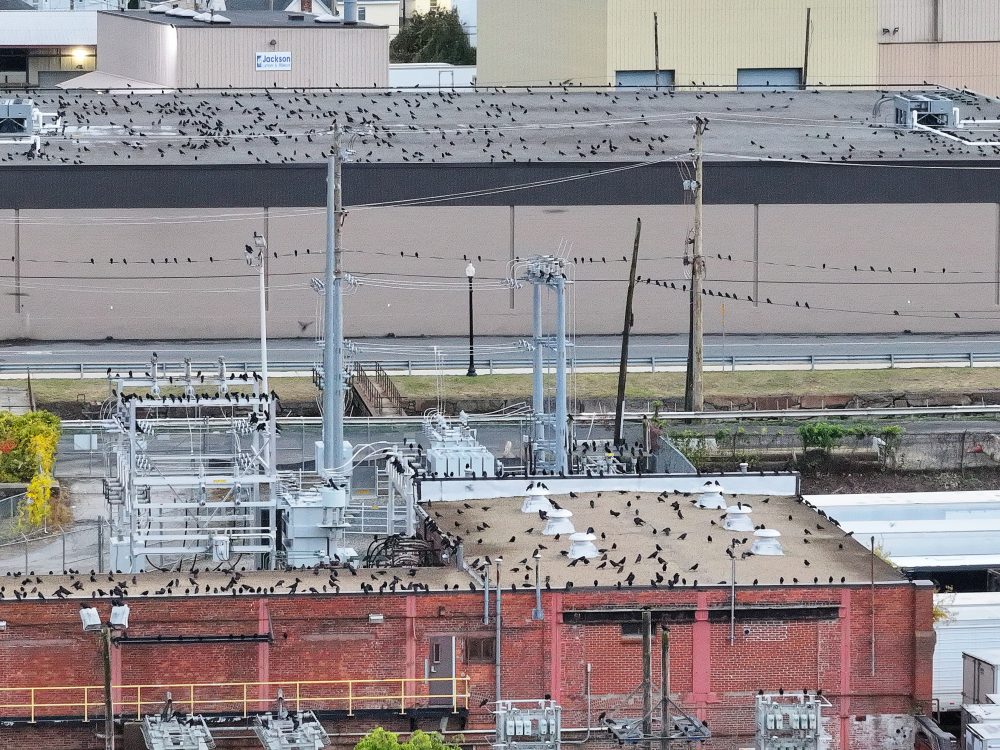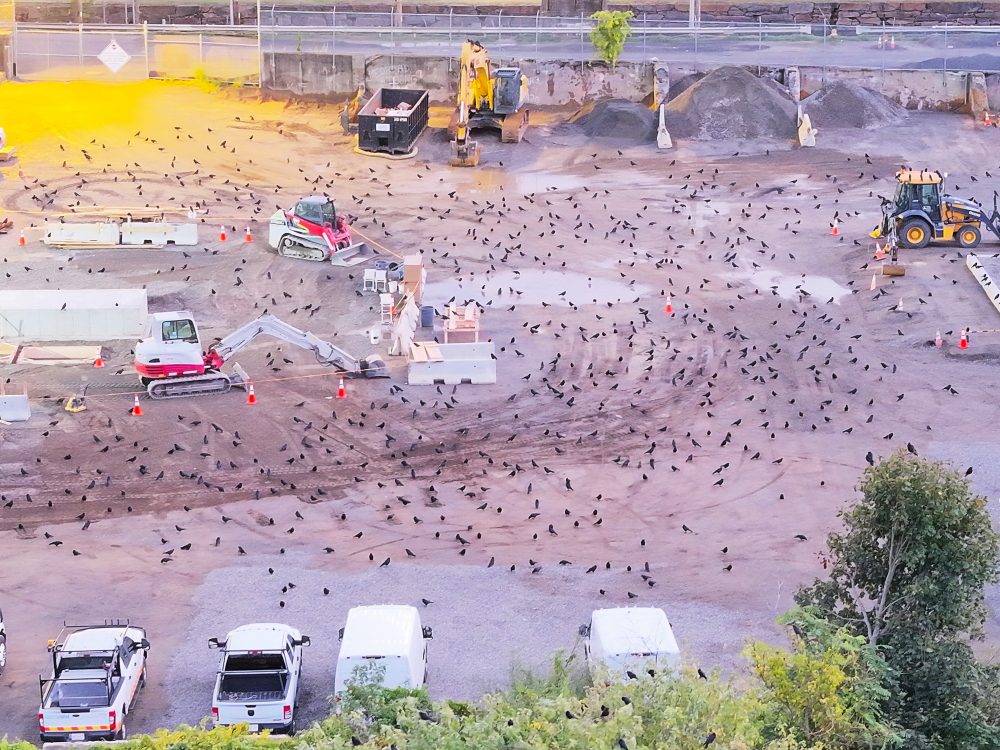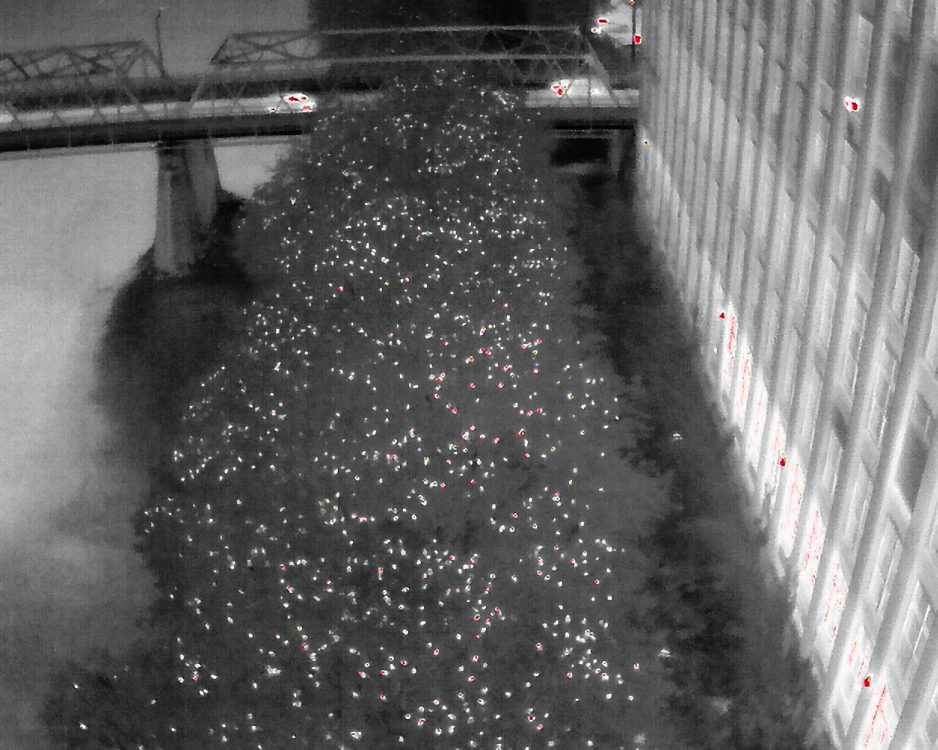Terrific aerial views!
Oct. 14, 2025: under overcast, wind NE 6MPH, 57F; sunset time 6:03PM
Upon arrival, scouted out nearby staging areas all along Merrimack Street, then made observations from South Canal Street with Crows vocalizing loudly and seen on the ground, rooftop edges, and utility wires before converging into overnight roost. It was fascinating to watch the equidistant line up of mostly Fish Crows along the utility wires on the south side of South Canal Street. Their almost uniform spacing may reflect social order, visual awareness, and readiness for a coordinated flight into the roost. This aerial view shows mostly Fish Crows tightly packed together on utility wires between multiple sets of poles.

With a range of new aerial views we are much better able to view the buildup on nearby rooftops. This views provide a better sense of the overall numbers and how they arrive and build up in different but proximate rooftop locations. This view shows rooftops in the closer National Grid substation facility as well as the roof farther away on top of the warehouse building on the south side of Merrimack Street.

As these Crows gather together after sunset time, but before converging into the overnight roost, they are often seen on the ground in the National Grid substation. This aerial view not only helps to appreciate the spacing in between Crows on the ground, but also allows for accurate counting in a staging location. For most viewers it might be a surprise to know that this view shows just over 825 Crows on the ground!

Finally, this Crow Patrol outing included time to linger around the roost until well after dark. This aerial view below, captured with a thermal camera, in “tint” color palette mode, looking to the east and downriver along the line of treetops, towards the Duck Bridge, shows the remarkable spacing of the roosting Crows in the overnight roost. The “tint” palette uses a soft, two-tone color range that highlights subtle temperature differences without harsh contrast, making it especially effective for behavioral observations and roost documentation. It preserves detail and structure within dense groups of roosting birds, preventing heat “white-out,” while maintaining visual context of surrounding branches, wires, and open gaps. This palette may be especially useful for interpreting spacing, flock density, and movement. Its subdued tones reduce glare and eye strain, allowing comfortable, extended nighttime monitoring and producing a more nuanced, readable image of how birds are arranged, interact, and settle in their roost.

For the 2024 Audubon Christmas Bird Count (CBC) for the Andover Circle (MAAN), the separate Crow Count was a total 12,550 Crows, including American Crows and Fish Crows. In 2023, the CBC Andover Circle Crow Count was 11,600. Many thanks to Donna Cooper who coordinates and compiles the CBC Andover Circle each year! Craig serves as the designated sector leader for the crow roost count.
The counts and methods meticulously developed by the Crow Patrol for the Lawrence roost were reviewed and approved in January 2021. This took place after a full review of all field notes and images, followed by group discussion with Wayne Petersen, the New England Regional Editor for the CBC, full support from Geoff LeBaron, the National Director of the CBC, and Donna Cooper as the local CBC Count Circle compiler. After this comprehensive review process, the final count for American Crows for the 2020 CBC was set at 15,200. This final count reflected the detailed field reports and imaging provided by members of the Crow Patrol. This count number was also in total alignment with a long list of experienced local birders who have made prior counting visits to this winter roost in Lawrence, MA!
As a result of substantial input from Geoff LeBaron, the National CBC Director, we are now using enhanced methods for counting the large number of Crows while streaming, staging, and settling into the roost. For all counts, we utilize multiple direct block counts of the Crows in flight and later while the Crows are perched in trees, always while standing and walking around outside (not sitting in a car after dark) around the roost. For all roost images, we use a modified open source counting software program, to carefully document and cross check our count numbers. This comprehensive approach significantly increases the reliability and accuracy of our carefully documented results. Please refer to our newly published Winter Crow Roost counting guide PDF on the main page.
For our still images, the Canon R6 mirrorless cameras excels in low-light photography due to its 24 MP sensor with fewer and larger pixels, allowing for better light collection and signal-to-noise ratio. The R6 II offers high dynamic range for detail retention, low digital noise even at high ISOs (up to 102,400), effective image stabilization for sharper images, and advanced image processing to minimize noise in dark areas.
The Canon mirrorless cameras with the RF 50mm f/1.2 lens and the RF 28-70mm F2 lens excel in low-light conditions, blending versatile focal lengths with an ultra-wide aperture. Both focal lengths work extremely well in very low light conditions because the f/1.2 and f2 aperture settings ensure exceptional performance in low light, offering stunning clear, and aesthetically pleasing images, making them ideal for the challenging very low light conditions around any overnight winter crow roost.
Remember to check out the latest Crow Patrol Podcast with John Macone (Merrimack River Watershed Council): wintercrowroost.com/podcast/
Photo gear used for most outings:
Canon EOS 80D with Canon EF-S 18-135mm f/3.5-5.6 IS
Canon EOS 80D with Canon EF-S 18-135mm f/3.5-5.6 IS (Infrared)
Canon EOS R6 Mirrorless with Canon RF 28-70 f/2 L IS USM
Canon EOS R6 II Mirrorless with Canon RF 50 f/1.2 L USM
Sony AX700 4K HDR Camcorder
Follow us on Instagram: wintercrowroost
Follow us on YouTube: wintercrowroost


Leave A Comment